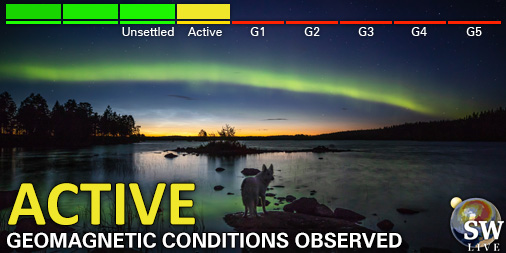Просмотр архива за среда, 14 мая 2003
Отчет о солнечной активности
Любая солнечная вспышка, упомянутая в этом расчете, имеет масштабирующий коэффициент, применяемый Центром прогнозирования космической погоды (SWPC). Из-за него солнечные вспышки здесь на 42% слабее, чем в научных данных. Из наших архивов этот коэффициент был удален, чтобы показать реальные величины вспышек.
Отчет о солнечно-геофизической активности 2003 May 14 2200 UTCПодготовлено NOAA © SWPC и представлено SpaceWeatherLive.com
Совместный отчет USAF/NOAA о солнечной и геофизической активности
Количество SD 134 на уровне 2200Z 14 May 2003IA. Анализ активных солнечных регионов и активности от 13 - 2100Z до 14 - 2100Z
Solar activity was very low. Region 360 (at S04 W19)
was numbered.
IB. Прогноз солнечной активности
Solar actvity is expected to be very
low to low for the next 24 hours. Two new active regions on the
east limb (returning Regions 336 at latitude N13 and 337 at S12) may
become the source of isolated C-class flares in the following days.
IIA. Обзор геофизической активности от 13 - 2100Z до 14 - 2100Z
The geomagnetic field has been at unsettled to minor storm levels due
to high speed solar wind streams from a favorably positioned coronal
hole. The greater than 2 MeV electron flux at geosynchronous orbit
reached high levels today.
IIB. Прогноз геофизической активности
The geomagnetic field is
expected to be at unsettled to minor storm levels for the next day,
falling off to unsettled to active on days two and three. The
coronal hole causing high speed solar wind streams is rotating out
of geoeffective position.
III. Вероятность события от 15 - May до 17 - May
| M-класс | 10% | 10% | 15% |
| X-класс | 01% | 01% | 01% |
| Протон | 01% | 01% | 01% |
| PCAF | green | ||
IV. Радиоизлучение λ = 10,7см
Наблюдаемый 14 May 096 Прогнозируемый 15 May-17 May 105/110/115 среднее значение за последние 3 месяца 14 May 125
V. Геомагнитные индексы
Наблюдаемый Afr/Ap 13 May 024/027 По оценкам Afr/Ap 14 May 025/025 Прогнозируемый Afr/Ap 15 May-17 May 020/020-015/015-015/015
VI. Вероятность геомагнитной активности с 15 - May до 17 - May
| A. Средние широты | |||
|---|---|---|---|
| Активно | 35% | 25% | 25% |
| Слабый шторм | 20% | 15% | 15% |
| Большой шторм | 10% | 05% | 05% |
| B. Высокие широты | |||
|---|---|---|---|
| Активно | 35% | 35% | 35% |
| Слабый шторм | 15% | 15% | 15% |
| Большой шторм | 10% | 05% | 05% |
Все время в UTC
<< Перейти на сегодняшнюю страницу обзора
В настоящее время нет никакой примечательной космической погоды
Последние новости
Последние сообщения с форума
2025/04/12-13 Filament CMEs 2025/04/16 G3 Watch 514Space Weather Memes 693May 2024 storm created a new Van Allen belt 29AR4062 41Incoming & Unnumbered Active Regions 1748
Больше темПоддержка SpaceWeatherLive.com!
Большое количество посетителей приходят на сайт SpaceWeatherLive, чтобы получить информацию о состоянии Солнца, его активности или возможном появлении полярного сияния. Однако с увеличением трафика растет и стоимость хостинга. Если вы находите наш сайт SpaceWeatherLive.com полезным, пожалуйста, подумайте о пожертвовании на его содержание и поддержку!

Сообщения и прогнозы
04:15 UTC - Геомагнитная активность
Активные геомагнитные условия (Kp4) Порог достигнут: 03:57 UTC
02:30 UTC - Индекс мощности полушарий
Модель OVATION предполагает, что индекс мощности полушарий достигнет 50 ГВт в 03:23 UTC
среда, 16 апреля 2025
21:45 UTC - Геомагнитная активность
Небольшая геомагнитная буря G1 (Kp5) Порог достигнут: 21:36 UTC
21:00 UTC - Геомагнитная активность
Мощная геомагнитная буря G4 (Kp8) Порог достигнут: 20:55 UTC
19:45 UTC - Геомагнитная активность
Сильная геомагнитная буря G3 (Kp7) Порог достигнут: 19:25 UTC
Факты о космической погоде
| Последняя X-вспышка | 28/03/2025 | X1.1 |
| Последняя M-вспышка | 15/04/2025 | M1.2 |
| Последняя геомагнитная буря | 16/04/2025 | Kp8- (G4) |
| Безупречные дни | |
|---|---|
| Последний безупречный день | 08/06/2022 |
| Среднемесячное количество солнечных пятен | |
|---|---|
| марта 2025 | 134.2 -20.4 |
| апреля 2025 | 120.5 -13.7 |
| Последние 30 дней | 118.3 -22.1 |






